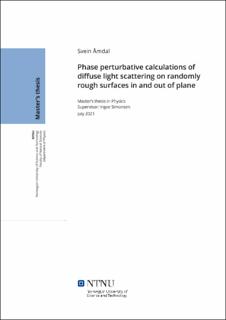| dc.contributor.advisor | Simonsen, Ingve | |
| dc.contributor.author | Åmdal, Svein | |
| dc.date.accessioned | 2021-11-01T18:21:41Z | |
| dc.date.available | 2021-11-01T18:21:41Z | |
| dc.date.issued | 2021 | |
| dc.identifier | no.ntnu:inspera:80800066:28777906 | |
| dc.identifier.uri | https://hdl.handle.net/11250/2827068 | |
| dc.description.abstract | Ved en eller annen lendgdeskala viser alle overflater en grad av ruhet, og det er viktig å forstå de fysiske konsekvensene av det. Denne oppgaven handler om refleksjon av elekromagnetiske bølger i det optiske bølgelengderegimet på tilfeldige rue overflater, som beskrives av statistiske autokorrelasjonsfunksjoner på Gaussisk form. Den inkoherente midlere differensielle refleksjonskoeffesienten for slike overflater beregnes ved hjelp av faseperturbasjonsteori, som er en approkismasjonsmetode. Den numeriske utregningen forenkles videre ved å utføre noen integraler analytisk, og den gjenstående styrende ligningen løses numerisk. De beregnede refleksjonsamplitudene sammenlignes med tidligere anskaffede eksperimentelle målinger og direkte numeriske løsninger. På denne måten vurderes teoriens nøyaktighet, og noen generelle trekk ved spredning på rue overflater blir observert og diskutert.
Totalt sett reproduserer den nåværende implementasjonen de generelle fasongene og trekkene som forventes innen spredning på rue overflater, og teorien later til å være en bedre approksimasjon enn den nært relaterte liten-amplitude-perturbasjonsteorien. Men, det er likevel en viss forskjell mellom de nåværende og tidligere anskaffede resultatene. Hovedårsaken til dette antas å være at den aktuelle ruhetstopografien er for stor til at approksimasjonen er gyldig. | |
| dc.description.abstract | At some length scale or another, all surfaces show a degree of roughness, and it is imperative to understand the physical implications of it. This work tackles reflection of electromagnetic waves in the optical wavelength regime on randomly rough surfaces, described by statistical autocorrelation functions of Gaussian form. The incoherent mean differential reflection coefficient is calculated for such surfaces using the approximate method of phase perturbation theory, whose numerical computation is further simplified by performing some analytical integrals. The simplified governing equation is solved numerically, and the calculated reflection amplitudes are compared to previous experimental measurements and direct numerical solutions. In this way, the accuracy of the theory is assessed, and some of the general features of rough surface scattering is observed and discussed.
Overall, the present implementation of phase perturbation theory largely reproduce the general shape and features that is expected in rough surface scattering, and seems to be a better approximation than the closely related small-amplitude perturbation theory. However, there is still a difference between its result and those obtained previously. The main reason is believed to be that the involved roughness topography is too severe for the chosen approximation to be valid. | |
| dc.language | eng | |
| dc.publisher | NTNU | |
| dc.title | Phase perturbative calculations of diffuse light scattering on randomly rough surfaces in and out of plane | |
| dc.type | Master thesis | |
